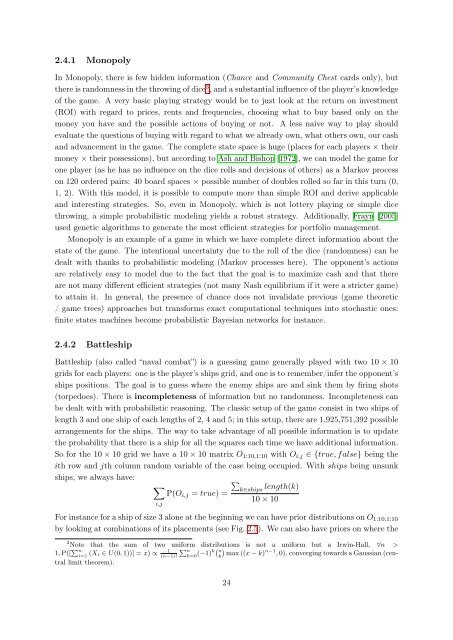Bayesian Programming and Learning for Multi-Player Video Games ...
Bayesian Programming and Learning for Multi-Player Video Games ...
Bayesian Programming and Learning for Multi-Player Video Games ...
You also want an ePaper? Increase the reach of your titles
YUMPU automatically turns print PDFs into web optimized ePapers that Google loves.
2.4.1 Monopoly<br />
In Monopoly, there is few hidden in<strong>for</strong>mation (Chance <strong>and</strong> Community Chest cards only), but<br />
there is r<strong>and</strong>omness in the throwing of dice 3 , <strong>and</strong> a substantial influence of the player’s knowledge<br />
of the game. A very basic playing strategy would be to just look at the return on investment<br />
(ROI) with regard to prices, rents <strong>and</strong> frequencies, choosing what to buy based only on the<br />
money you have <strong>and</strong> the possible actions of buying or not. A less naive way to play should<br />
evaluate the questions of buying with regard to what we already own, what others own, our cash<br />
<strong>and</strong> advancement in the game. The complete state space is huge (places <strong>for</strong> each players × their<br />
money × their possessions), but according to Ash <strong>and</strong> Bishop [1972], we can model the game <strong>for</strong><br />
one player (as he has no influence on the dice rolls <strong>and</strong> decisions of others) as a Markov process<br />
on 120 ordered pairs: 40 board spaces × possible number of doubles rolled so far in this turn (0,<br />
1, 2). With this model, it is possible to compute more than simple ROI <strong>and</strong> derive applicable<br />
<strong>and</strong> interesting strategies. So, even in Monopoly, which is not lottery playing or simple dice<br />
throwing, a simple probabilistic modeling yields a robust strategy. Additionally, Frayn [2005]<br />
used genetic algorithms to generate the most efficient strategies <strong>for</strong> portfolio management.<br />
Monopoly is an example of a game in which we have complete direct in<strong>for</strong>mation about the<br />
state of the game. The intentional uncertainty due to the roll of the dice (r<strong>and</strong>omness) can be<br />
dealt with thanks to probabilistic modeling (Markov processes here). The opponent’s actions<br />
are relatively easy to model due to the fact that the goal is to maximize cash <strong>and</strong> that there<br />
are not many different efficient strategies (not many Nash equilibrium if it were a stricter game)<br />
to attain it. In general, the presence of chance does not invalidate previous (game theoretic<br />
/ game trees) approaches but trans<strong>for</strong>ms exact computational techniques into stochastic ones:<br />
finite states machines become probabilistic <strong>Bayesian</strong> networks <strong>for</strong> instance.<br />
2.4.2 Battleship<br />
Battleship (also called “naval combat”) is a guessing game generally played with two 10 × 10<br />
grids <strong>for</strong> each players: one is the player’s ships grid, <strong>and</strong> one is to remember/infer the opponent’s<br />
ships positions. The goal is to guess where the enemy ships are <strong>and</strong> sink them by firing shots<br />
(torpedoes). There is incompleteness of in<strong>for</strong>mation but no r<strong>and</strong>omness. Incompleteness can<br />
be dealt with with probabilistic reasoning. The classic setup of the game consist in two ships of<br />
length 3 <strong>and</strong> one ship of each lengths of 2, 4 <strong>and</strong> 5; in this setup, there are 1,925,751,392 possible<br />
arrangements <strong>for</strong> the ships. The way to take advantage of all possible in<strong>for</strong>mation is to update<br />
the probability that there is a ship <strong>for</strong> all the squares each time we have additional in<strong>for</strong>mation.<br />
So <strong>for</strong> the 10 × 10 grid we have a 10 × 10 matrix O1:10,1:10 with Oi,j ∈ {true, false} being the<br />
ith row <strong>and</strong> jth column r<strong>and</strong>om variable of the case being occupied. With ships being unsunk<br />
ships, we always have:<br />
�<br />
P(Oi,j = true) =<br />
i,j<br />
�<br />
k∈ships length(k)<br />
10 × 10<br />
For instance <strong>for</strong> a ship of size 3 alone at the beginning we can have prior distributions on O1:10,1:10<br />
by looking at combinations of its placements (see Fig. 2.5). We can also have priors on where the<br />
3<br />
Note that the sum of two uni<strong>for</strong>m distributions<br />
�<br />
is not a uni<strong>for</strong>m but a Irwin-Hall, ∀n ><br />
n−1<br />
max ((x − k) , 0), converging towards a Gaussian (cen-<br />
1, P([ �n 1<br />
i=1 (Xi ∈ U(0, 1))] = x) ∝ (n−1)!<br />
tral limit theorem).<br />
� n<br />
k=0 (−1)k� n<br />
k<br />
24


